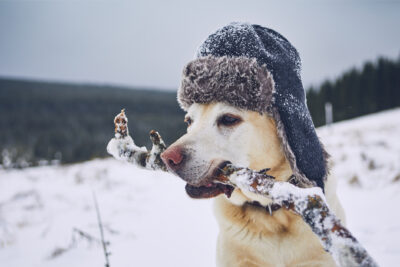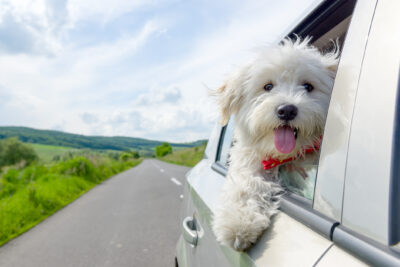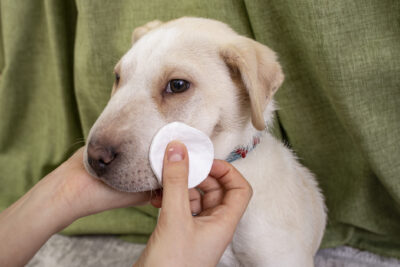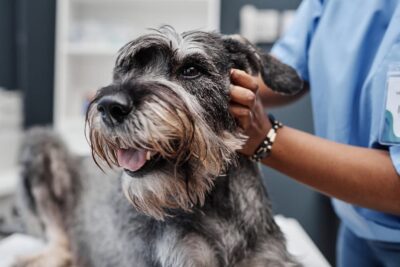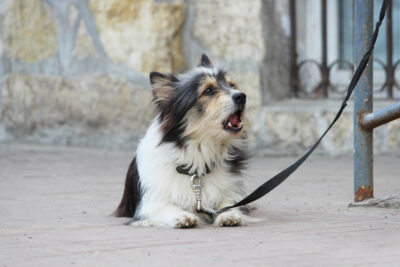Fly Bites on Dogs: Should You Worry?

Ticks and fleas are not the only problematic bugs pestering dogs. Fly bites on dogs aren’t just an annoyance – they can cause irritation, swelling, and even severe allergic symptoms or secondary infections.
If you’ve got a working dog or one that lives in rural areas or likes spending time outdoors, it’s likely that your pet could be exposed to black flies (horse flies or buffalo gnats), mayflies, sand flies, filth-breeding flies, and biting midges (no-see-ums), among others. These winged insects can transmit diseases and their bites can be uncomfortable for your dog.
Keep reading for details about what flies to watch out for, what fly bites look like on dogs, and ways to treat and prevent future bites.
What Types of Flies Are Dangerous to Dogs?

There are two types of flies that can bother the domestic dog. According to Dr. Stephanie Sheen, a veterinarian with Brookswood Animal Clinic, there are biting flies and non-biting flies. These are often found in streams, wooded areas, or in standing water. “These types of environments tend to be more common in rural areas.”
Biting flies cause painful bites that could become infected if not treated appropriately, says Sheen. “Because biting flies feed on blood, they can also transmit diseases via that route,” she adds. In some rare occasions, fly bites may also cause allergic reactions in pets.
Biting flies include:
- Black flies: Also known as turkey gnats or buffalo gnats because they are known to swarm large animals, these tiny flies have large, fan-shaped wings. They are found in north temperate and subarctic zones, as well as in tropical and subtropical areas. They tend to breed in streams, so it’s a good idea to keep your pet away from streams during fly breeding season to limit your pet’s exposure.
- Biting midges (no-see-ums): These are small gray insects that are less than 1/8th of an inch long. They inflict painful bites and are often found in muddy areas near ponds, salt marshes, and streams.
- Sand flies: Sand flies are carriers of leishmaniasis, a blood parasite that also affects humans. However, these flies are typically found in tropical and subtropical climates and are not in the United States.
Non-biting flies do not bite the animal, but instead feed on bodily secretions such as saliva, tears, and mucus. They transmit bacteria and viruses when they land and feed.
Non-biting flies include the following:
- Face flies: These get their name because they like to surround the muzzle and eyes of an animal, and are found near livestock in rural areas.
- Head flies: Also known as plantation flies, these insects resemble the common house fly and are generally found in northern European countries in areas with livestock. They are attracted to the secretions from the nose, mouth, eyes, ears, and wounds.
- Filth-breeding flies: These are similar to the common house fly and breed in animal feces and carry diseases.
Signs and Symptoms of Fly Bites on Dogs

Fly bites on dogs look differently, depending on the fly. For example, Sheen says a black fly’s bite creates a circular rash around the bite, “sometimes appearing like a bull’s eye pattern, with the bite in the center and a red rash around the outside.” These tend to appear on the dog’s belly and inner thighs, when they lay down.
Other types of bites appear as small red dots. Some bites may not show any signs at all, especially if your pet has a heavy coat.
Some flies like feeding on dog’s ear tips, as they are easily accessible. The German Shepherd dog, which has upright ears, has a slightly higher risk of getting bitten by flies than other breeds, says Sheen.
Spider bites may look similar to fly bites, but they can cause necrosis – or tissue death – around the area of the bite, leading to more complicated healing, according to Sheen. Tick bites cause a small raised bump, but they typically do not have the “bulls eye” appearance.
Signs of fly bites, according to Sheen include:
- Itchiness, causing the dog to scratch, lick or chew the impacted area.
- Small red bumps or larger rash and circular “bullseye” type rash.
- Secondary infection or infestation from flies laying eggs in open wounds. Newborn puppies with healing umbilical cords, dogs with open bites or laceration wounds, and matted hair with feces are all highly susceptible to flies laying eggs. The eggs develop into maggots which feed on dead tissue and fecal material. These maggots can go unnoticed if the dog has severely matted fur. When this occurs, seek immediate veterinary intervention.
How to Treat Fly Bites on Dogs

If you notice any signs of fly bites on your dog, get a veterinary evaluation. Typically, black fly bites on dogs heal without medical attention. However, if your dog continues to suffer from itching, Sheen recommends the following next steps:
- Cold compresses to provide relief. This can be done with putting ice cubes in a bag and placing it over the impacted area and applying it 10 to 15 minutes at a time, with sufficient breaks.
- Use hydrocortisone or other steroid-containing cream or spray specifically designed for dogs to reduce redness and itching. Use a dog e-collar or a t-shirt over the area so your pet doesn’t lick the treatment off and get sick from it.
If you notice signs of anaphylaxis (a severe allergic reaction), do not attempt to treat it at home. Anaphylaxis is a rare occurrence to a fly bite, but is an emergency. Signs of anaphylaxis include facial swelling, hives, lethargy, excessive drooling, vomiting and diarrhea. This could also lead to further problems such as difficulty breathing and shock, which is why it’s key to contact a veterinarian immediately.
How to Keep Flies Off Dogs

One of the most important things to do to keep the flies away is by maintaining your dog’s environment to be as clean as possible, and that includes the yard and their sleeping areas. A well-groomed dog is also less likely to suffer from any fly egg infestations. Here are a few ways you can keep flies away and prevent dog fly bites:
Yard: Sheen suggests promptly removing any animal feces from outdoor spaces, especially in the summer months. She also recommends clearing out rotting yard debris, cutting back dense brush and removing any standing water, to reduce the insect population.
Dog-safe fly repellents: Some flea and tick prevention products also repel mosquitos and other biting insects. Pet parents can use fly repellent for dogs in the form of sprays. However, Sheen suggests to never using human products on pets. Additionally, while natural products, including those that use essential oils, may help, Sheen doesn’t think they are as effective as more potent options.
Grooming: Get your dog groomed regularly. “Be sure to promptly address any matted fur or fecal matter on the coat which are common attractants for maggots,” suggests Sheen.
Inspection: Check your dog regularly for any signs of swelling or redness. If you notice anything out of the ordinary, reach out to your veterinarian.
